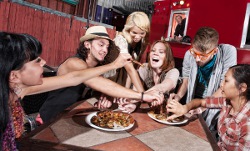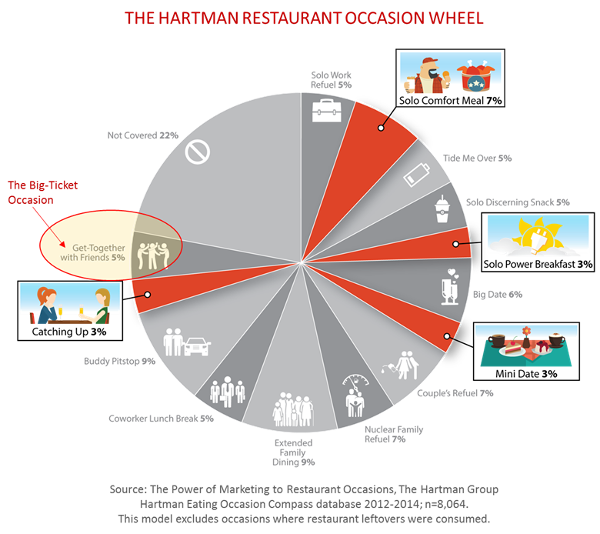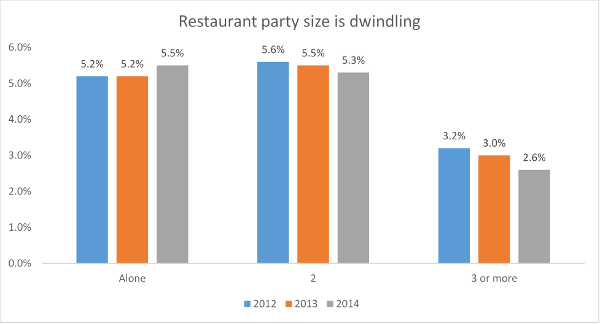Cheers to That: Social Dining Is a Big-Ticket Restaurant Occasion
 There wasn’t much mystery behind Applebee’s decision back in 2013 to branch out in to late night operations with its “Bee’s Late Night,” which saw the family dining format transformed into a lively bar scene with black-light parties, karaoke and dancing. Quite simply, the chain saw opportunity in encouraging younger diners to socialize (and, of course, order apps, meals and drinks).
There wasn’t much mystery behind Applebee’s decision back in 2013 to branch out in to late night operations with its “Bee’s Late Night,” which saw the family dining format transformed into a lively bar scene with black-light parties, karaoke and dancing. Quite simply, the chain saw opportunity in encouraging younger diners to socialize (and, of course, order apps, meals and drinks).
Of course, the restaurant “Get-Together with Friends” occasion isn’t relegated to any particular age demographic—it’s a time-honored practice used to celebrate any number of occasions ranging from birthdays to holidays and workplace or sports events. As we all know, going out to eat with a group of friends can be the highlight of pretty much anyone’s week. And, no great mystery, it’s also a restaurant opportunity for big, higher-margin tabs. Unfortunately, according to analysis of eating occasions conducted by The Hartman Group, consumers seem to be doing fewer get-togethers today compared with two years ago—so what can restaurants do to reinject some excitement for such occasions?
The Hartman Group’s The Power of Marketing to Restaurant Occasions report finds that Get-Together with Friends eating occasions make up 5 percent of all restaurant occasions. These events consist of a group of three or more (not counting significant others) guests who get together to socialize, de-stress and enjoy good foods and beverages. As any waitstaff would point out, group occasions such as these are more likely to include alcohol.
Our analysis finds that 21.4 percent of the Get-Together with Friends occasion segment involves alcohol (and is more likely to involve alcohol compared with any other measurable restaurant occasion) and is the only occasion where alcohol surpasses carbonated soft drinks in terms of what’s consumed. If the margins from alcohol weren’t enough to convince restaurant operators of the value of Get-Together with Friends occasions, they should also consider that these occasions:
- Have a significantly low price sensitivity.
- Lean towards premium restaurants.
- Are more often at full-service restaurants.
- Are less likely to be food-only occasions.
The social stakes at Get-Together with Friends occasions are high. Not only are such occasions not terribly common, they’re usually made unique by the particular combination of friends who gather. It may be one of a very small number of times per year for friends within a particular group to get together. Celebration in combination with stress relief and perceived rarity means that people will spend in greater proportion to match the perceived importance of the situation.
Of interest, group restaurant occasions like Get-Together with Friends have been steadily declining in recent years. We believe the same social fragmentation that has produced growth in eating alone is making it more difficult for consumers to coordinate around each other’s varying schedules to assemble at restaurants. For consumers, the increased rarity of group restaurant occasions may in turn lead to even less price sensitivity. For restaurants, this could mean bigger spending from groups that are showing up less often. Though innovating for diners who eat alone should be front of mind for restaurant and chain marketers today, it is important to remember how much of current sit-down revenue models are built around serving groups.
Hartman Eating Occasion Compass; adult occasions, 2012 n=20,179; 2013 n=21,151; 2014 n=21,841.
Source: Hartman Eating Occasion Compass 2012-2014; Restaurant Occasions: n=8,064; Get-Together with Friends. Occasion, n=380.
If this trend intrigues you, consider findings displayed in The Hartman Restaurant Occasion Wheel, which depicts a taxonomy of consumer behavior towards restaurant selection. Our Restaurant Occasion Wheel illustrates how social and emotional goals are connected as well as who is included in the occasion. The Restaurant Occasion Wheel shows when and where the occasion takes place and if it’s culturally meaningful. So far we’ve uncovered 14 culturally distinct occasions that encompass 78 percent of restaurant-sourced eating.

Consumers are dramatically changing their eating behaviors: perhaps we can all take a cue from Applebee’s, which saw merit in extending operating hours to encourage new behaviors in their formats that include social dining. In the hyper-competitive restaurant world of today, targeting restaurant occasions and understanding more about what is behind the motivations, needs and desires of diners as they make their decisions to “eat out” is a meaningful, relevant way to capture market share.
Click here to download a free copy of our Hartbeat Exec: The Power of Marketing to Restaurant Occasions

